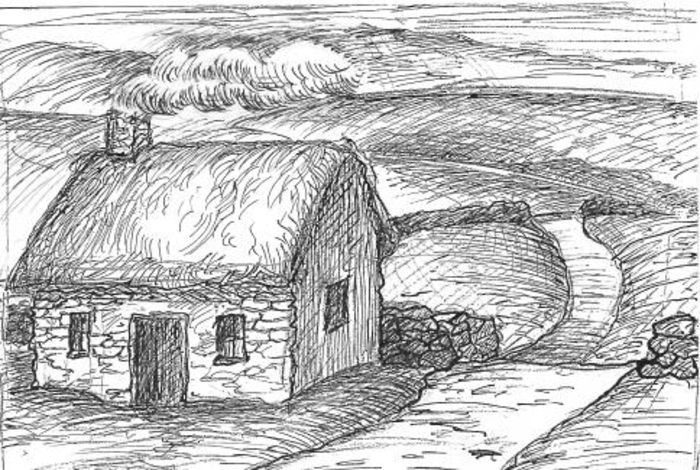Nearly two centuries after the Bodkin family embarked on their famine era journey to the United States, their descendent Jack Bodkin returned to Briarhill, driven by the desire to find the ancestral family home. In this article, Bodkin recounts the experience, his connection to the area and how his family's story inspired his novel, 'Briarhill to Brooklyn'.
I’ve never lived in Briarhill, and it’s been seventy-five years since my family left Brooklyn, but in the last ten years, I’ve been to both places several times while researching my novel 'Briarhill to Brooklyn'.
I’ve called West Virginia home for the last fifty years, and yes, I was born in Brooklyn. My father and grandfather were Brooklynites, too. But my great-grandfather, Martin Bodkin, took his first Irish breath in Briarhill, County Galway. Martin was just a young lad in 1848 when his family emmigrated to America, but it’s a graying, sixty-six-year-old Martin I use as my narrator to tell the Bodkins’ story in Briarhill to Brooklyn.
Searching for the family cottage
Bodkin is not a common Irish name, and learning about my Irish ancestors has been exciting. Writing Briarhill to Brooklyn with my family as the main characters (and having it enjoyed by thousands of readers ) has been sensational. But driving on a narrow one-lane road and imagining my great-grandfather may have been on that same path in a horse-drawn cart more than 175 years ago takes me over the moon.
While visiting Galway in 2017, we were having breakfast at the Park House Hotel when my wife suggested we drive to Briarhill to look for the family’s old cottage. The concierge gave us directions to Briarhill, and we were off.
Fifteen minutes later, I pulled our car into a Mercedes dealership across from the Briarhill Shopping Centre, went inside, and asked a salesman, “Which way to Briarhill?” He said, “Well, you’re here.” I was hoping for something else. We were standing in a car dealer’s parking lot at the busy N6, Parkmore Road, and R339 intersection, with a hotel and a busy shopping mall across the street.
I told him what I was trying to do: “My family lived in Briarhill in the 1840s, and I’d love to find their cottage.” Understandably, he asked if I had an address. After I answered, “No, all I have is Briarhill,” he pointed toward the traffic on R339, “It could be anywhere along that road. Just drive up that way for a mile or two, make a right or a left on one of the small crossroads, and see what you find.”

A sketch of the imagined Bodkin family home in Briarhill drawn by artist, Dan Buchwach.
The search continues
We followed his directions, got on R339, and quickly left the congested intersection. We drove along looking at the houses and decided nothing looked like it was there in 1848. Near Connolly’s auto repair shop, I got adventurous and made a left off R339 onto a road that didn’t have a name or a number. It was a one-lane road with some houses spread along it. Again, nothing looked old enough to be my ancestors’ cottage. We kept driving, navigating the turns, a couple of oncoming cars and a small herd of cattle moving from one field to another.
Eventually, we arrived at Duffy’s Equestrian Centre and asked a woman where we would end up if we kept following the road. She said it would lead to N83 in about a mile, and if we turned left on N83 we would return to Galway. We followed her directions and were again a little disappointed that we hadn’t found a cottage—not even the ruins of a cottage—that looked like it could have been the Bodkins’ home.
Visualising the past
After a few miles on N83, we came to Saint Columba’s Church in Castlegar. I had been to Saint Columba’s on my first trip to Galway and saw the baptismal records of my great-grandfather and a few of his siblings. Those baptismal records listed the Bodkins’ townland as 'Briarhill'.
We parked the car and toured the church again, and as I sat in one of the pews I imagined: if my ancestors had lived somewhere on that winding, nameless, one-lane road, they could have made the three or four-mile journey in a horse-drawn cart to go to Sunday Mass at Saint Columba’s. My imagination kept going and picked a spot on the road, about halfway between Connolly’s and Duffy’s. Then the Bodkins’ thatched roof, two-room cottage appeared to me, and the prologue of Briarhill to Brooklyn began with the family crowding around the table in their Briarhill home, and the children’s mam saying the family had to go to America.
Briarhill to Brooklyn is historical fiction in which I tell the story of my ancestors’ lives between 1848 and 1902. My family left Briarhill and County Galway on a ship named Cushlamachree. They settled in Brooklyn, and the American Civil War impacted the family substantially as two brothers enlisted in the Union Army and spent time on battlefields in America’s South.
I’ve never spoken with anyone with ancestral roots in Briarhill, but I’d love to. Maybe a Galwegian who reads this article had a great-great-grandmother who passed down stories about where she lived, and who her neighbours were; perhaps she had a neighbour named Bodkin. Please get in touch with me at [email protected].

Jack Bodkin
Jack Bodkin was born in Brooklyn, and grew up in Long Island. A retired certified public accountant, 'Briarhill to Brooklyn' is his first book. Since 1977, Bodkin has resided in West Virginia. He is passionate about preserving and researching his family's history, interested readers can get in touch with him by emailing [email protected]. Briarhill to Brooklyn is available at the Galway Public Library, amazon.com (print, audiobook, and eBook ), and local bookstores will probably order it for you. Enjoy the read.

